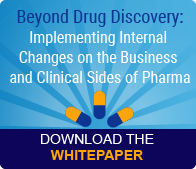Like so many other industries, Pharma is experiencing rapid and highly disruptive change focused on driving innovation and cost efficiencies, all at an accelerated pace. It’s a complex and competitive environment. Clinical  process improvement, R&D process changes, re-structuring, new regulatory requirements, and new technology are all more challenging in what is often a matrixed, global structure. What’s more, changes go well beyond drug discovery: transformational changes are also impacting the business side of Pharma.
process improvement, R&D process changes, re-structuring, new regulatory requirements, and new technology are all more challenging in what is often a matrixed, global structure. What’s more, changes go well beyond drug discovery: transformational changes are also impacting the business side of Pharma.
Unfortunately, the highly disciplined and rigorous approach that’s found on the drug discovery side of the house doesn’t always translate to the business side, where changes are often managed without taking into account cultural and other human barriers. The result: failed or stalled out projects, and projects that don’t achieve all the intended outcomes.
Pharma’s Industry-Specific Challenges to Implementing Project Changes
There are some factors that make the Pharma industry “special and unique” when it comes to the people and cultural elements of transformational change. For example:
- Sponsorship Issues: Scientists, who are highly skilled subject matter experts, often lack the leadership skills and business acumen to be effective Sponsors of a change. Scientists have technical expertise, but not people management expertise.
- Risk Adverse Culture: Given the nature of the work on the drug discovery side and the obvious need to be vigilant in regulatory compliance and risk identification and management, Pharma’s tend to be culturally risk-averse. This conflicts with the simultaneous need to drive innovative change, which needs a safe environment for failure in order to flourish.
- Matrix Organizations: Pharma organizations tend to be highly complex and heavily matrixed. Therefore, there is not always clarity around roles and accountabilities.
- Focus on Project Management: Pharma’s often lack the number of professional project management resources needed to implement the volume of internal, non-drug development changes that are occurring. It’s not unusual to find managers who serve in the role of project leader. Their focus is on technical milestones, budget, and timeline without the necessary rigor and discipline on the people side of the change.
What’s Needed to Build Implementation Capability
So what does it take to build implementation capability in Pharma? First, it takes leaders who recognize how their own behavior drives full implementation success. “Full success” is measured by achievement of the timeline, budget, and technical objectives, of course, but also the business and human objectives. The single most important factor in achieving all these outcomes at speed is how the Sponsors Express, Model and Reinforce their public and private commitment on a daily basis. So Scientists who are Sponsors have to get out of the lab and take an active, visible role in the change well beyond project launch.
Second, Pharma organizations should adopt a structured implementation process that can be married with other critical business protocols like Agile or Lean Six Sigma. Absent a common framework for managing the human and cultural elements of strategic initiatives, organizations are far more likely to take too long, spend too much, and increase the likelihood that the desired changes are not sustained over time.
IMA’s proprietary change management framework, The Accelerating Implementation Methodology (AIM), offers a robust set of strategies, tactics, tools, and measurement diagnostics for managing the human elements of any project, no matter the size or complexity. From business process improvement to transformational change, the AIM change management methodology ensures you achieve all the desired outcomes.
The AIM Structured Process Drives Implementation and Business Value
AIM identifies a core set of actions that address the people and cultural side of a change. It is a fit-for-purpose, data-based system that has great appeal in scientific and analytical cultures. Key elements include:
- Define the Change- The starting point for every business change should be a clear, compelling definition of the change that includes the human behaviors needed in the future state.
- Build Change Agent Capacity- Projects must have the right resources in the right places with the right knowledge, skills, traits, and characteristics to achieve full implementation. Change Agents must not only have the right skill set, but they also must have the right relationships with both the Sponsors and Targets of the change.
- Assess the Climate- What are the cultural barriers to change? Does past history suggest a track record of implementation failures? AIM’s Implementation History Assessment diagnostic is a statistically validated tool for getting this valuable data so that project teams know how to target their limited resources for greatest impact in the shortest amount of time.
- Generate Project Sponsorship- The cascade of active, visible Sponsors who are Expressing, Modeling and Reinforcing the desired new behaviors associated with the change down and across the enterprise is the most important factor in any project’s success.
- Develop Target Readiness for the Change- Investing in target readiness early means less resistance to be managed later on. While you can never eliminate resistance, you can identify it and manage it with specific strategies and tactics.
- Build a Communication Plan- Every message must be targeted to the right audience at the right time, using the most appropriate media possible, and must include a feedback loop to gather data on potential sources of resistance.
- Develop a Reinforcement Strategy- Process follows reinforcement. If you don’t change the reinforcement, you won’t get behavior change. It’s just that simple.
A great solution that is poorly implemented will not produce value realization. Whether you are implementing a business change or a clinical change, you can’t ignore the human and cultural impacts. When Pharma’s manage the people side of a change with the same rigor and discipline as the technical side, the result will be faster implementations with a much greater likelihood of system optimization.


